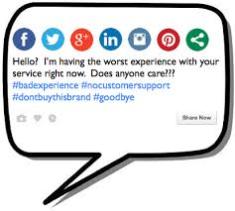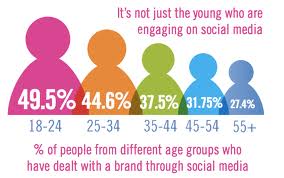A couple of weeks ago I had the opportunity to listen in on an online webinar hosted by Social Media Today (click here for the audio/slideshow presentation). While the webinar, sponsored by SAP, an international software industry titan that offers system integration platform solutions for companies looking to manage their software systems, spoke quite a bit about how using SAP’s programs would help businesses manage their social media programs, it also offered quite a bit of interesting information on the shift in providing customer service from call centre and email based to that of incorporating social media as well. The webinar had feature speakers from the Discover credit card, T-Mobile cell phone service and Nissan Auto manufacturers (all SAP customers.)
As we’ve been learning through our studies, business in general is starting to recognize that more and more of the public is active on social media, and that as this image from econsultancy.com shows, it’s not just the younger generation, but those in various age-groups, often favouring contacting their favourite brands through social media over and above that of traditional communication methods. If they are communicating with those brands via social media, it then stands to reason that customer service requests are being made through those avenues as well.
Where I work, providing customer service via various different stakeholders make up easily 75 per cent of my job description. So I was very interested to see what I could learn via the webinar. It was interesting to note that while using social media to respond to customer service requests did not make up a huge portion of most companies’ resources, it has been steadily increasing over the last four years. And while those starting to reply to their customers via social media reported a 32 per cent increase in their positive customer service responses, it still took a formulated, strategic method make it work the best. Facebook was still considered the platform of choice with Twitter increasing over the years (case in point – T-Mobile had used a very aggressive social media campaign using the power of Twitter to see huge spikes in tweets and retweets with a growth of +464 per cent per year in social connections and +845 per cent per year in social growth leading to being ranked fourth in the incredibly competitive mobile market in the USA.)
So what does it mean to provide customer service via social media?
Listening to the representatives from Nissan, T-Mobile and Discover it can all be boiled down to this:

Image from http://www.suvonni.com
- If you are going to be on social media, you have to be where your customers are (research and identify where your target audience hangs out).
- If you are where your customers are, you also have to be prepared to interact with them, and be committed to responding back to them (pretty basic, I know – but how many times have you commented on a brand’s Facebook page or sent them a tweet only to be ignored?)
- A company needs to have strategy on how they are going to address customer service requests – detailing how frequently they will monitor the sites (are they only 9-5 or 24/7?), to the voice and tone representatives would use in their responses so that it is in keeping with the brand, are they going to respond back within the site or direct them elsewhere, etc.
- Watch what others are doing well and learn from their mistakes and successes.
- And providing excellent customer service on social media is still very much based on providing excellent customer service anywhere else: listen, respond as promptly as possible, be authentic and aim for resolution.
- Depending on the size of the company this strategy needs to be communicated with internal stakeholders with responsibilities defined between departments so that conversations highlighting the need for change discussed on social media can be shared.
- Not everything can be resolved and a company needs to make sure that if a discussion gets out of hand it is managed and if needed closed off. This perhaps is the hardest lesson of all, as sometimes no matter how much you try, you just can’t make everyone happy. How all your customers are handled is probably the most vital part of all, as it will influence how your company and brand is forever perceived.




